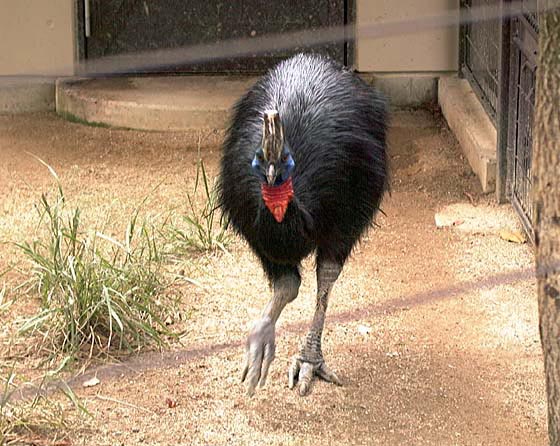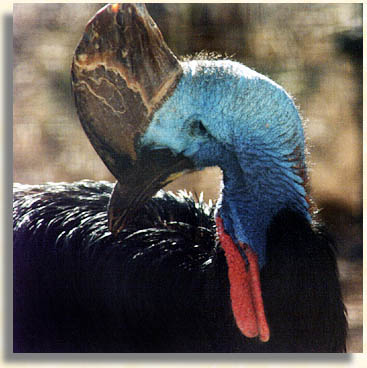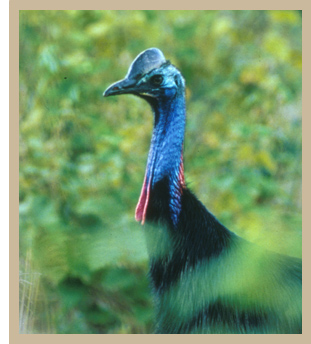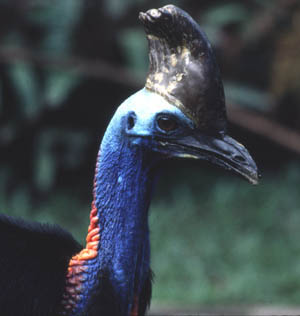Casuarius casuarius (Southern Cassowary)
 Adult
Adult
Description: Huge, flightless birds with long necks and legs and prominent casque on the head. They have black feathers and bare skin on their legs, necks and heads. The head and neck is variable in colour but is usually blue with red on the back of the neck and the two throat wattels are red also. The legs are creamy brown. The casque and beak are brown and the eyes reddish brown.
The bare parts change shade with their mood and are always brighter in females and the casque is longer in females.
The casque was once thought to be a bony extension of the birds skull, however recent reaserch has shown that the center of the casque contains a very tough, elastic, foam-like substance.
 Adult
Adult
The function of this protuberance has been debated at long length and there are two ideas on this subjects, the first is that the casque is used to help the bird to force its way through thick forest vegetation, helping it to push the plants appart and protect its head from damage. The second takes note of the fact that the casque grows slowly throughout the birds life, young birds surely need to get through vegetation as rapidly and easily, so why does it take time to develope, this suggests that the casque indicates age and dominace of the bearer, and is thus a social tool. Captive birds have been observed using the casque as a tool for finding food in the leaf litter.
Their plumage is extremely course and hard, this is probably to protect the birds from thorns, sharp leaves and the humidity of the forest. The feathers appear loose and hair like as they lack interlocking hooks and rectrices.
The wings are much reduced and the smallest of all the large flightless birds. The remiges are reduced to 5-6 bare quills, which curve round beneth the bird and probably protect the flanks from thorns and sharp objects in the dense forest habitat.
The legs and feet are robust and powerful, they have three toes and each is equipped with a stout claw, the inner toe has a 10 cm long, dagger-like claw, which it can use as a terrible weapon.
Size: 130-170 cm.
Weight: Male 29-34 kg, female 58 kg.
Senses: They can run at speeds of up to 50 km/h and can jump 1.5 m from a standing possition. They are also good swimmers and can cross lacks and rivers without difficulty.
Habitat: In New Guinea they are typically found in rainforest at moderate altitudes, but also in gallery and swamp forest and savanna woodland. Often seen along the forest edge or at river banks, they will live up to 500 m, rarely higher. In Australia they are restricted to dense tropical rain forest and occur at any altitude.
 Adult
Adult
Range: They are generally sedentary but do make some irregular nomadic movements, especially in areas with close human contact.
They hold territories all year. Mlae birds will threaten intruders, they make themselves appear larger by bristling up their feathers and arching their bodies upwards, then they look at the ground and boom at the intruder, inflating their neck and trmbeling all over, this is usually only expressed during the breeding season and the innitial posture of the threat is used to initiate courtship.
Distribution: Most of New Guinea except NC and highlands; Aru Island (E Indonesia); two isolated populations in NE Queensland (Australia) and Seram, where they are thought to be and introduced species.
Status: Not globally threatened. Failry widespread in New Guinea, though presently rare or absent in many ares where they where formally common. This decline is due to habitat destruction and hunting pressures. Apparently they are not uncommon in the lowlands of C Seram, in costal forests some birds are taken as pets or hunted.
In Australian they are limited to two isolated populationsin rain forests of NE Queensland, the density is unknown, but they are clearly threatened at a local level, due to habitat destruction and disturbance. Feral pigs are thought to cause problems for the birds as they compete for food with them and even eat their young and eggs. Other birds are killed by cars.
 Adult
Adult
Daily Rhythm: Activity takes place mostly in the early morning and late afternoon, as well as on moonlit nights. In the middle of the day they tend to rest, using regular site where they can sit in the sun, and never far from a good food source. Most of their time is spent in search of food, and they use specific feeding areas regularly, this often means that they have paths cut through the undergrowth that leads them around their territoy, they also have regular crossing areas for rivers and streams.
Voice: They can produce a variety of different sounds, they vary with hteir mood and activity. It is though that outside the breeding season they are much more silent.
They typical threat call is a rumbling sound, which is given as a warning to any introuding birds. Other sounds include hisses, whistles, low-rumbling growls, bill clapping as a threat and loud roars during fights.
During the breeding season males utter a low "boo-boo-boo", which are more frequently produced at the start of the season, especially just prior to copulation.
Enemies: Feral pigs are thought to take eggs and chicks.
Although they are usually shy they will attack if they are cornered, especially if they are accompanied by chicks. Attacks are usually preceeded by a display in which the bird arches its body upwards, bristling its feathers towards its rump, this makes the bird appear larger. It then bends its neck downwards, pointing its bill to the ground and makes a deep booming sound, with the neck inflated and the body shaking.
When the bird actually attacks they raise their body and kick out with both feet a once, or else they race past, kick out as they pass. When they re pushed to such aggression they can be formidable opponents, the long dagger-like claws can kill a dog or man quite easily. However, open aggression is not natural to the birds, when they are chased they will normally try to outrun their persuer, they rush through thick vegetation with the head and neck stretched out horizontally in front, the casque and primary quills protecting the head and body in turn.
Prey: Omnivorous. Mainly fallen fruits (Lauraceae, Myrtaceae, Elaeocarpaceae, palem), also some fungi, invertebrates, small vertebrates and even some carrion.
Food and Feeding: Fruit is mostly picked up of the ground, occasionally it is taken from a low bush. In captivity they consume about 2.9 kg/day.
Grouping: Very little is known about wild birds as they are very hard to observe. On detecting an approaching human they usually disappear into dense vegetation before they are spotted. Tracks and droppings are very often the only evidence of its presence.
They are solitary outside the breeding season, and appear to keep terriotries all year.
Breeding: The breeding season falls between June-October in Queensland, starting at the end of the dry season in New Guinea.
Females are succesivily polyandrous.
When courting females appear to hold dominace and males will turn and flee at the first sign of threat from a female.
Gestation: Males incubate for about 50 days.
Litter Size: Each clutch contains 3-5 eggs.
Young Description: Juveniles are uniform brown with dull bare parts and a rudimentary casque.
Eggs are dark green and average a size of 135 x 95 mm, and a weight of 584 g.
 Chick
Chick
Nest:
Young Care: The male cares for and incubates the eggs alone, the chicks do not become independent until they are about 9 months old.
Sexual Maturity:
Longevity:
Back to Main Page
Back to Birds